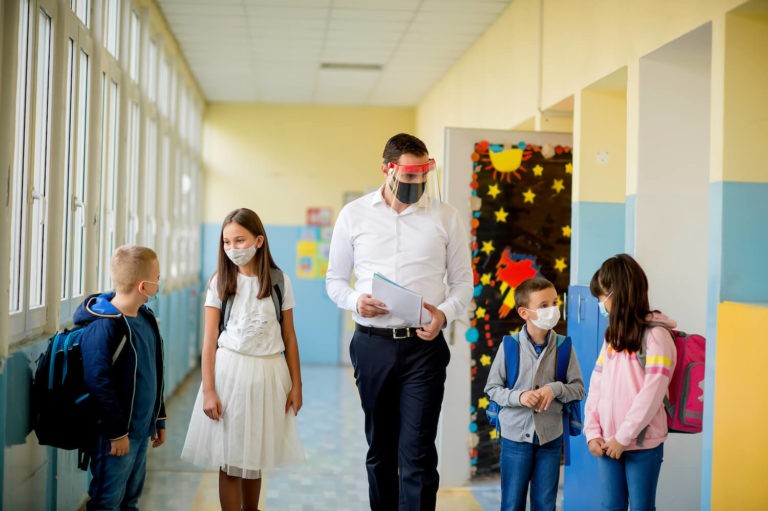At the start of the COVID-19 pandemic, administrators and school staff were charged with the task of reinventing most concepts of the way school was commonly run. Some schools were not reopening their physical facilities but entering a new realm of virtual classrooms. Schools that did reopen to students in classroom attendance had to figure out to follow health and safety guidelines for every aspect from entering the school in the morning, classroom seating, lunchroom configuration, and school departure all while social distancing and keeping areas clean and sanitized. As the 2020-2021 school year progressed, school staff began to realize that some of these practices were highly effective and discovered some pandemic changes are here to stay.
Use of Technology for Instruction
Prior to the pandemic, teachers were just beginning to utilize online platforms for instruction and assessment. As schools closed their facility doors for safety reasons, teachers soon realized there was a need to use such virtual learning systems as Google Classroom, Canvas, and Blackboard Learn to provide instruction and assignments virtually. As students returned to the brick and mortar facility, teachers continued to rely on such learning systems which allows the teacher to differentiate instruction, quickly grade assignments turned in virtually, and manage online tasks for student participation. When asked if they would continue to utilize these learning systems after the restraints of the pandemic were gone, the majority of teachers at one school agreed that such platforms would continue to be used daily.
Engaging Students Through Technology
Technology was not just used for instruction. While teaching virtually, technology was a means of engaging students and teachers quickly became familiar with many ways to involve students. Virtual field trips were used to motivate students and activities could easily be tied to standards, so learning was still rigorous. Virtual games such as Kahoot, Quizlet, Classcraft, and Padlet allowed teachers to gamify their classroom and boost participation online. In addition, many teachers found short video clips to help teach skills during asynchronous learning. Even after students returned to class, teachers have continued to use these engaging practices to enhance instruction.
Social Distancing
While many will agree that social distancing has been a struggle within a school, there are aspects that have proven to be beneficial. Prior to the pandemic, students all gathered in one or two central locations before and after school on “bus duty.” Due to social distancing, some schools had to find means of separating students from other grades during these times of the day to limit contact tracing. With this separation, teachers began to realize that students were quieter when spread out in various locations. Many teachers didn’t mind a few extra days of early or late duties because the noise level and activity were minimized.
Building Relationships
The majority of teachers have always been great at building relationships with the students within their class. However, due to the pandemic, teachers realized the need to make special connections in order to ease fears concerning the pandemic, to boost social and emotional needs, and to encourage virtual participation. For many educators, students’ well-beings became just as important as their learning. Teachers became advocates to make sure students were fed and they became nurses watching out for signs of illness. They realized that students were missing the opportunity to see their grandparents or other family who had been quarantined, and students were anxious about the unknowns. Many teachers stepped up to fill the needs, and in doing so developed an understanding for the importance of building these special relationships with students and families.
Focus on Classroom Cleaning
In the pre-pandemic classroom, teachers would often wait for the janitor to come and clean the classroom once a day. The pandemic, however, changed the way many teachers looked at sanitizing and sharing materials. No longer are students sharing supplies, as materials are now distributed on an as-needed basis. Not only has this slowed the spread of COVID-19, but many schools have reported fewer instances of strep, flu, and even colds as the use of community supplies has been eliminated. In a similar manner, teachers have become accustomed to sanitizing desks throughout the day and encouraging hand washing more frequently due to CDC guidelines. The effect of such frequent cleaning is a positive one, so the practice of keeping a clean classroom is bound to stay after the pandemic has dissipated.
Virtual Meetings
One thing with which many educators have become very familiar is the virtual meeting. Whether for classroom instruction, a faculty meeting, an Individual Educational Plan (IEP), or a parent conference, teachers have utilized Zoom, Google Meets, Teams, and other platforms for hosting meetings. While most teachers will tell you they prefer to teach in a real classroom, many have discovered that this is an effective means of communication with parents and other educators.
While there is no denying that people are ready to return to normal, there are still many practices teachers and administrators plan to continue implementing long after COVID is conquered. Educators have always been eager to adapt to the challenges set before them, and in doing so, many have discovered creative solutions to connect with students and boost instruction. They have found many pandemic changes are beneficial and here to stay.




